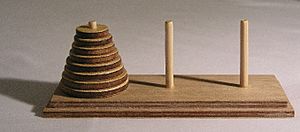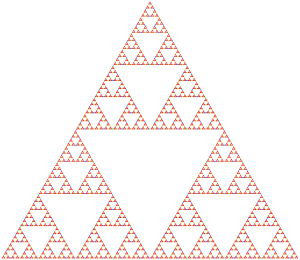The Tower of Hanoi – Myths and Maths facts for kids

The Tower of Hanoi – Myths and Maths is a cool book about puzzles. It focuses on the famous tower of Hanoi puzzle, the baguenaudier (also called Chinese rings), and other similar brain teasers. Andreas M. Hinz, Sandi Klavžar, Uroš Milutinović, and Ciril Petr wrote it. The first version came out in 2013, and a bigger, updated version was released in 2018. This book is so good that some experts even suggested it for college math libraries!
Contents
Exploring Puzzle Worlds
Even though this book is about fun puzzles, it takes them very seriously! It connects puzzles to many interesting school subjects. These include how computers think (like automata theory), how hard problems are to solve (computational complexity), how to design smart ways to solve problems (algorithms), and how shapes and connections work (graph theory and group theory). It also touches on topology (the study of shapes), fractal geometry (patterns that repeat themselves), and even psychology (how our minds work). Puzzles like these can even be used in psychological testing!
The Classic Tower of Hanoi
The book starts by telling the story of the Tower of Hanoi puzzle. It covers how a French mathematician named Édouard Lucas invented it. He even made up a cool mythical story about it!
Meet the Chinese Rings
Next, the book talks about the Baguenaudier puzzle, also known as the Chinese rings. This puzzle is like the Tower of Hanoi because it also takes a really long time to solve. It probably even inspired Lucas when he created his puzzle!
Solving the Tower of Hanoi
Chapter two dives into the main puzzle: the Tower of Hanoi. In its classic form, you have to move disks one by one between three towers. The rule is simple: a bigger disk can never go on top of a smaller disk. The book shows different ways (called algorithms) to solve this puzzle as fast as possible. It explains how to move all disks to one tower, even if they start in different places.
Understanding Hanoi Graphs
The book also introduces Hanoi graphs. These are like maps that show all the possible moves and positions in the puzzle. The number of steps you take to solve the puzzle is like the distance you travel on this map.
Puzzles with a Twist
The book then explores different versions of the Tower of Hanoi.
- Some puzzles have disks that aren't neatly sorted at the start.
- Others use more than three towers.
- Sometimes, disks can only move between certain towers or in specific directions.
- The rules about where disks can be placed might even be changed!
A very important version is the Reve's puzzle. It's just like the classic Tower of Hanoi, but it has four towers instead of three. For a long time, no one knew the fastest way to solve it. But in 2014, after the first book came out, the answer was finally found! The updated second edition of the book includes this exciting discovery.
Colorful Illustrations
The book has many colorful pictures and photos. These help to explain the puzzles and ideas better.
Who Should Read This Book?
This book is for different kinds of readers.
For Math Lovers
If you love math and puzzles, this book is for you! Experts say it's a must-read for mathematicians who study puzzles.
For Curious Minds
It's also great for anyone who enjoys fun math challenges. One reviewer, László Kozma, said that even if some parts are detailed, it's interesting and easy enough for high school students to understand.
A Deeper Dive
However, another reviewer, Cory Palmer, mentioned that it's not a "casual read." He said you need to understand combinatorics (a type of math about counting and arranging things) to fully get it. Charles Ashbacher even suggested it could be used for a college course!
What Reviewers Say
Most people really like the book. Andrew Percy called it "an enjoyable adventure" and said it was "humorous, and very thorough." Martin Klazar called it "wonderful" and suggested it to anyone interested in puzzles or math. While one reviewer, S. V. Nagaraj, found some errors, the overall feedback is very positive!


